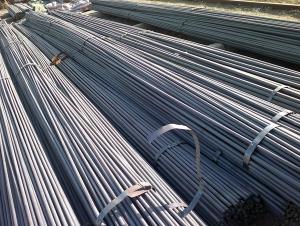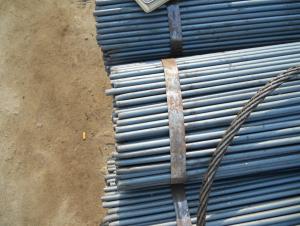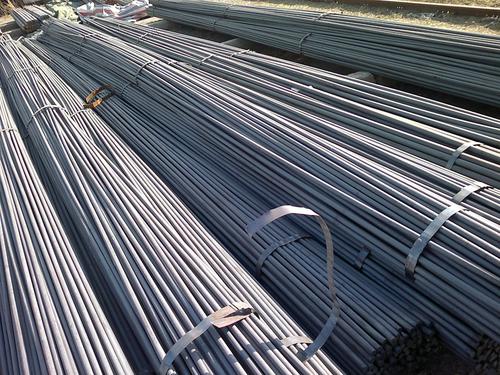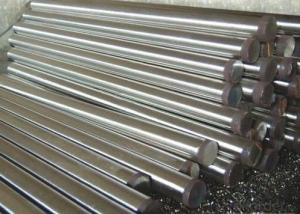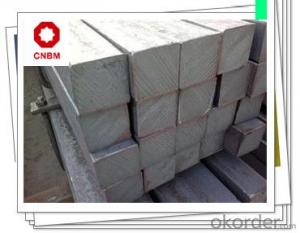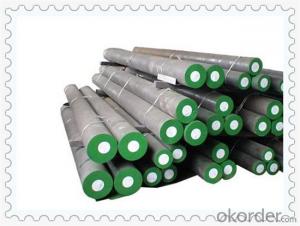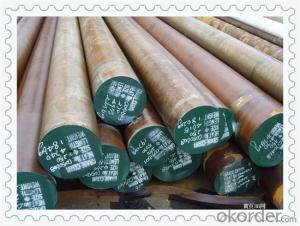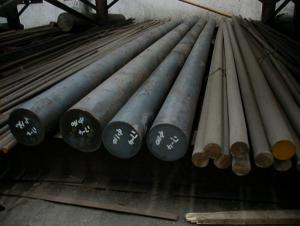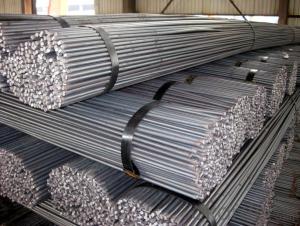Plain Bar
- Loading Port:
- China Main Port
- Payment Terms:
- TT OR LC
- Min Order Qty:
- -
- Supply Capability:
- -
OKorder Service Pledge
OKorder Financial Service
You Might Also Like
Specifications of High Quality Round Bar
1. Grade: GB, JIS, ASTM, EN
2. Grade: Q235, SS400, A36, S235JR
3. Diameter and mass: As below
Diameter | Mass | Diameter | Mass | Diameter | Mass |
(mm) | (kg/m) | (mm) | (kg/m) | (mm) | (kg/m) |
6 | 0.22 | 22 | 2.98 | 53 | 17.30 |
7 | 0.30 | 24 | 3.55 | 56 | 19.30 |
8 | 0.40 | 25 | 3.85 | 60 | 22.20 |
9 | 0.50 | 26 | 4.17 | 63 | 24.50 |
10 | 0.62 | 28 | 4.83 | 65 | 26.00 |
11 | 0.75 | 30 | 5.55 | 70 | 30.20 |
12 | 0.89 | 32 | 6.31 | 75 | 34.70 |
13 | 1.04 | 34 | 7.13 | 80 | 39.50 |
14 | 1.21 | 36 | 7.99 | 85 | 44.50 |
15 | 1.39 | 38 | 8.90 | 90 | 49.90 |
16 | 1.58 | 40 | 9.86 | 95 | 55.60 |
17 | 1.78 | 42 | 10.90 | 100 | 61.70 |
18 | 2.00 | 45 | 12.50 | 120 | 88.85 |
19 | 2.23 | 48 | 14.20 | 140 | 120.93 |
20 | 2.47 | 50 | 15.40 | 150 | 138.82 |
4. Material: Mild Steel
5. Heat treatment of high quality steel:
Fire: Isothermal annealing temperature is 800 ~ 880 °C, with 10 ~ 20 °C, the furnace cooling to about 600 °C, hardness above HB269.
Preheat temperature: 730-730 °C
Quenching temperature: 1190-1210 °C
Tempering temperature: 540-595 °C
Cold drawn, hardness 285 HBS
Cold drawn after annealing condition, hardness 277 HBS
Quenching methods: oil quenching, air cooling or salt bath quenching
Usage and Applications of High Quality Round Bar
1) Suitable for making various strong cutting tool abrasion resistance, impact resistance.
2) Used to produce all kinds of high hard and super hard saw blade, drill, tap, broach, gear hob and various kinds of milling cutter.
3) Used for advanced punching die, screw die, and the toughness and complicated shape of the punch, etc.
4) Is used for cold forging die and drawing mode, etc.
5) Recommended watchcase factory, screw factory and other cold stamping products industry use.
Packaging & Delivery of High Quality Round Bar
Packaging Detail: All goods are packed in bundle with steel strips and shipped by break bulk vessel or container (depend on target market and different ports)
Delivery Detail: 45 days
Trade terms: FOB, CFR, CIF
MOQ: 25 tons per specification; we can negotiate the quantity if the specification is normal or we have stock of one specification.
Weight: The price invoicing on theoretical weight basis or actual weight basis depends on customer’s request.
Shipment: The shipment of bulk break or container is depends on customer’s request and the situation of the port of destination.
Documents given: Full set of original clean on board bill of lading; Original signed commercial invoice; Original packing list; Policy of insurance; Certificate of origin and what the target market needs.
Production Flow of High Quality Round Bar
The common processes are preheated forging quenching, dual refinement solution process, cooling quenching and isothermal quenching. We use heat treatment for dual refinement solution process. The main measures process is high temperature solution and refinement cycle. High temperature solution can improve the carbide morphology and particle size. The aim is to make the loop refinement ultrafine austenite grains.
- Q: What are the different welding techniques for steel round bars?
- Steel round bars can be welded using various techniques. Here are some commonly used ones: 1. Stick welding, also known as Shielded Metal Arc Welding (SMAW): This technique involves using an electrode coated in flux to create an electric arc between the electrode and the workpiece. The base metal melts, resulting in a weld. 2. Gas Metal Arc Welding (GMAW), commonly referred to as MIG (Metal Inert Gas) welding: In this technique, a wire electrode is fed through a welding gun. It combines with a shielding gas to create a weld. 3. Flux-Cored Arc Welding (FCAW): Similar to GMAW, FCAW uses a continuously fed electrode. However, instead of a solid wire electrode, it uses a tubular electrode filled with flux. This flux protects the weld and adds strength. 4. Tungsten Inert Gas (TIG) welding, also known as Gas Tungsten Arc Welding (GTAW): This precise technique involves using a non-consumable tungsten electrode to create an arc. Additional material may be added using a filler rod. 5. Submerged Arc Welding (SAW): This technique is suitable for heavy-duty applications, such as welding steel round bars for structural purposes. The arc and welding zone are submerged in granular flux, providing protection and deep penetration. Each technique has its advantages and is suitable for specific applications. Factors like round bar thickness, required weld strength, and accessibility of the welding site should be considered when selecting the appropriate technique for a strong and durable weld on steel round bars.
- Q: What is the carbon content in steel round bars?
- The carbon content in steel round bars typically ranges from 0.15% to 0.60% depending on the grade and specific requirements.
- Q: 40CrMo what is the round steel material?
- High strength, high hardenability, good toughness, little deformation during quenching and high creep strength and lasting strength at high temperature.
- Q: Can steel round bars be coated?
- Indeed, it is possible to coat steel round bars. Coating them yields numerous advantages, such as enhanced resistance to corrosion, increased durability, and improved visual appeal. The most commonly utilized coatings for steel round bars encompass galvanized coatings, epoxy coatings, and powder coatings. Galvanized coatings encompass the application of a zinc layer onto the steel's surface, which provides exceptional protection against corrosion. Epoxy coatings, on the other hand, find common application in industrial settings due to their remarkable chemical resistance and ability to withstand harsh environments. Powder coatings, involving the electrostatic application of a dry powder, are then cured under heat to form a robust and protective layer. These coatings can be employed on steel round bars to safeguard against rust and other forms of corrosion, thereby rendering them suitable for a broad scope of applications across various industries, including construction, manufacturing, and automotive.
- Q: What are the advantages of using tungsten-alloy steel round bars?
- Tungsten-alloy steel round bars offer several advantages over other materials, making them a popular choice in various industries. Firstly, tungsten-alloy steel round bars have exceptional strength and durability. The addition of tungsten to the steel composition significantly improves its hardness and toughness, making it highly resistant to wear, deformation, and fatigue. This enhanced strength ensures that tungsten-alloy steel round bars can withstand heavy loads and high-pressure applications, making them ideal for use in industries such as aerospace, automotive, and construction. Another advantage of using tungsten-alloy steel round bars is their excellent heat resistance. Tungsten has one of the highest melting points among all elements, making it highly suitable for applications that involve extreme temperatures, such as furnace parts, cutting tools, and high-speed machinery. The heat resistance of tungsten-alloy steel round bars allows them to maintain their structural integrity and performance even in demanding environments, minimizing the risk of deformation or failure. Furthermore, tungsten-alloy steel round bars have superior corrosion resistance. The addition of tungsten to the steel alloy forms a protective oxide layer on the surface, which acts as a barrier against corrosive elements, moisture, and chemicals. This corrosion resistance makes tungsten-alloy steel round bars ideal for applications in marine environments, chemical processing plants, and oil and gas industries, where exposure to corrosive substances is common. Additionally, tungsten-alloy steel round bars provide excellent machinability. The hardness and toughness of these bars make them easy to shape, cut, and drill, allowing for precise machining and tight tolerances. This machinability makes tungsten-alloy steel round bars suitable for manufacturing intricate components and parts that require high precision and accuracy. Lastly, tungsten-alloy steel round bars have a high density, which gives them unique properties such as improved radiation shielding capabilities. This makes them valuable in industries where radiation protection is crucial, such as nuclear power plants, medical equipment, and aerospace applications. In conclusion, the advantages of using tungsten-alloy steel round bars include exceptional strength and durability, excellent heat resistance, superior corrosion resistance, excellent machinability, and high density for radiation shielding. These advantages make tungsten-alloy steel round bars a reliable and versatile choice for various industries, ensuring optimal performance and longevity in challenging environments.
- Q: What are the different types of surface defects in steel round bars?
- There are several types of surface defects that can occur in steel round bars, including scale, pits, seams, scratches, and decarburization.
- Q: How are steel round bars used in the manufacturing of hydraulic systems?
- Due to their strength, durability, and versatility, steel round bars are widely used in the manufacturing of hydraulic systems. These bars serve multiple purposes in the construction and assembly of hydraulic components. One primary application of steel round bars in hydraulic systems is for fabricating piston rods. Piston rods are crucial components of hydraulic cylinders that transfer the force generated by the hydraulic fluid to the desired mechanism. The high strength and rigidity of steel round bars make them ideal for this purpose, as they can withstand the intense pressure and stress exerted on the piston rod during operation. Steel round bars are also utilized in manufacturing shafts and axles within hydraulic systems. These components transmit rotational motion and torque from the hydraulic pump to other mechanical parts, such as gears or pulleys. By using steel round bars, manufacturers can ensure the reliability and longevity of these critical parts, as they possess excellent mechanical properties and resistance to wear and tear. Moreover, steel round bars are often employed in constructing hydraulic fittings and connectors. These components join different hydraulic pipes, hoses, or valves together, creating a sealed system for fluid transmission. Steel round bars provide the necessary strength and stability to withstand the high-pressure conditions within hydraulic systems, ensuring leak-free operation and efficient fluid transfer. In conclusion, steel round bars play a vital role in the manufacturing of hydraulic systems by providing strength, durability, and versatility. Their use in piston rods, shafts, axles, fittings, and connectors ensures the proper functioning and reliability of these systems.
- Q: Can steel round bars be machined easily?
- Yes, steel round bars can be machined easily due to their excellent machinability properties.
- Q: What are the different grades of steel used for round bars?
- There are several different grades of steel that are commonly used for round bars. These grades vary in their composition and properties, making them suitable for different applications. Some of the most common grades of steel used for round bars include: 1. Mild Steel (Low Carbon Steel): This is the most basic and widely used grade of steel. It has a low carbon content, which makes it easy to work with and relatively inexpensive. Mild steel round bars are commonly used in construction, automotive, and general engineering applications. 2. Carbon Steel: This grade of steel contains higher levels of carbon than mild steel, giving it improved strength and hardness. Carbon steel round bars are often used in high-stress applications, such as structural components, axles, and shafts. 3. Alloy Steel: Alloy steel round bars are made by adding various alloying elements, such as chromium, nickel, or molybdenum, to the base steel. This enhances the strength, toughness, and corrosion resistance of the material. Alloy steel round bars are commonly used in aerospace, automotive, and machinery industries. 4. Stainless Steel: Stainless steel is a corrosion-resistant grade of steel that contains high levels of chromium. It is known for its excellent strength, durability, and resistance to rust and staining. Stainless steel round bars are widely used in the food industry, marine applications, and architectural components. 5. Tool Steel: Tool steel round bars are specifically designed to have high hardness, wear resistance, and heat resistance. They are commonly used in the manufacturing of cutting tools, dies, and molds. These are just a few examples of the different grades of steel used for round bars. Each grade offers unique properties and characteristics, allowing for a wide range of applications across various industries.
- Q: What are the tolerance levels for steel round bars?
- Steel round bars have varying tolerance levels depending on the specific application and industry standards. To ensure precision in terms of diameter, straightness, and surface finish, steel round bars are typically produced with tight dimensional tolerances. Diameter tolerances specify the acceptable range of deviation from the nominal diameter of the round bar and are expressed as a plus or minus value, such as +/- 0.005 inches. The specific tolerance depends on the size, type of steel round bar, and application requirements. Straightness tolerances determine the allowable amount of deviation from a perfectly straight line along the length of the round bar. This tolerance is expressed as the maximum distance between the round bar and a straight edge placed along its length. For instance, a straightness tolerance of 0.030 inches per foot means that a one-foot section of the round bar can deviate up to 0.030 inches from a straight line. Surface finish tolerances specify the acceptable level of imperfections or irregularities on the surface of the round bar. This tolerance is often expressed using roughness average (Ra) or roughness peak (Rz) values. The specific tolerance depends on the desired surface finish and application requirements. It is worth noting that tolerance levels may also be subject to industry-specific standards established by organizations like the American Society for Testing and Materials (ASTM) or the International Organization for Standardization (ISO). These standards provide guidelines and specifications for various steel products, including round bars, to ensure consistent quality and performance. Ultimately, determining the tolerance levels for steel round bars involves considering the specific application requirements, industry standards, and the capabilities of the manufacturing process.
Send your message to us
Plain Bar
- Loading Port:
- China Main Port
- Payment Terms:
- TT OR LC
- Min Order Qty:
- -
- Supply Capability:
- -
OKorder Service Pledge
OKorder Financial Service
Similar products
Hot products
Hot Searches
Related keywords
